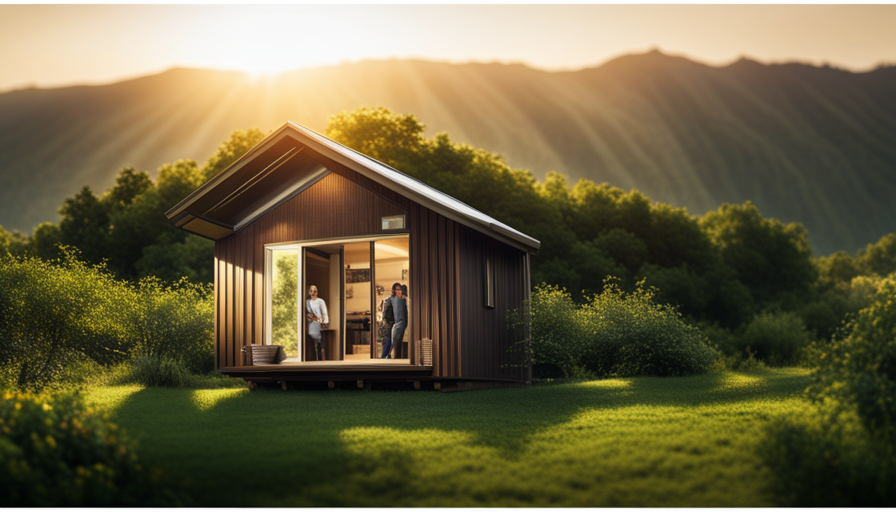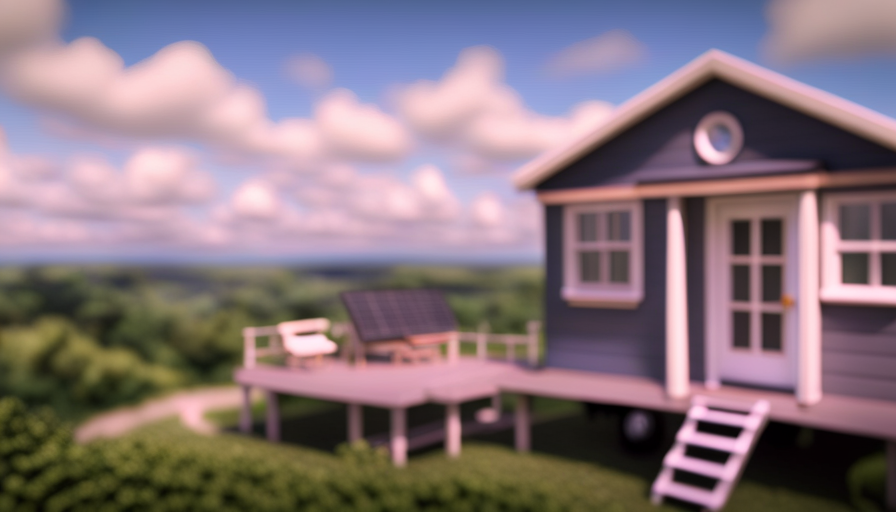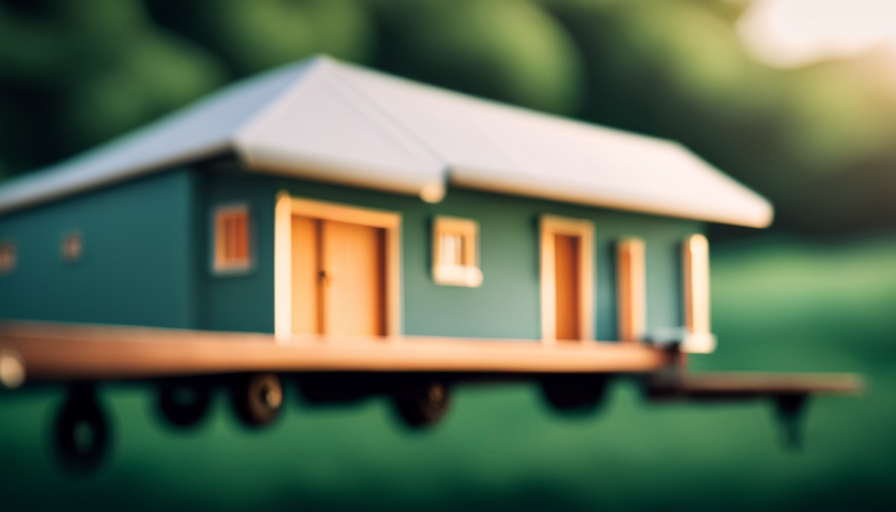Imagine your tiny house trailer as the sturdy foundation of your mobile dream home. It serves as the crucial center, similar to the beating heart of a well-oiled machine, essential for the strength and functionality of your small house.
But just how long can you expect your tiny house trailer to last?
In this article, I will delve deep into the construction, materials, and craftsmanship of a tiny house trailer to provide you with a comprehensive understanding of its lifespan. We will explore the importance of proper maintenance, the impact of climate and weather conditions, and the signs of wear and tear to look out for.
I will also share valuable tips on extending the lifespan of your tiny house trailer and guide you on when it may be time to consider a replacement.
If you’re ready to embark on the journey of tiny house living, join me as we unlock the secrets to maximizing the lifespan of your tiny house trailer and ensuring the longevity of your dream home on wheels.
Key Takeaways
- Tiny house trailers require proper construction techniques and high-quality materials to ensure durability and longevity.
- Regular inspections, maintenance, and care are essential for extending the lifespan of the trailer.
- Upgrading and reinforcing the trailer with options like adding cross members and upgrading the suspension system can enhance durability and strength.
- Choosing a reliable and trusted manufacturer is crucial for a sturdy and durable foundation. Researching different manufacturers and reading customer reviews helps make an informed decision.
Understanding the Construction of a Tiny House Trailer
So, how long does a tiny house trailer actually last? Well, you’ll be surprised to know that these trailers can withstand the test of time and provide a sturdy foundation for your tiny home for years to come.
The construction techniques used in building these trailers are specifically designed to ensure durability and longevity. One key aspect is the weight distribution system employed in the trailer’s design. This system evenly distributes the weight of the tiny house, preventing any undue stress on the structure. By carefully considering the weight distribution, the trailer can handle the load and maintain its structural integrity over time.
Additionally, the construction techniques used in fabricating the trailer involve the use of high-quality materials and craftsmanship. These trailers are built to withstand harsh weather conditions, road vibrations, and other external factors that may put stress on the structure. By incorporating all these elements, tiny house trailers can last for many years, providing a solid base for your tiny home.
Moving on to the subsequent section about quality materials and craftsmanship, it’s important to note that these factors further contribute to the overall longevity of the trailer.
Quality Materials and Craftsmanship
To ensure your tiny house trailer stands the test of time, be sure to invest in high-quality materials and expert craftsmanship. When it comes to the construction of a tiny house trailer, the use of durable materials and craftsmanship techniques is crucial for its longevity.
Here are three key elements to consider:
-
Frame: The frame is the backbone of your tiny house trailer, providing structural integrity and support. Opt for a frame made from strong and corrosion-resistant materials like steel or aluminum. Ensure that the frame is properly welded and reinforced to withstand the stresses of transportation and everyday use.
-
Flooring: The flooring of your tiny house trailer should be built to withstand heavy loads and constant movement. Choose materials such as plywood or composite decking that are known for their durability and resistance to moisture and rot. Reinforce the flooring with additional supports to prevent sagging or warping over time.
-
Exterior: The exterior of your tiny house trailer should be able to withstand the elements and protect the interior from water, wind, and other environmental factors. Consider using weather-resistant materials like metal siding or composite panels. Pay attention to the construction details, such as proper sealing and flashing, to ensure a watertight and long-lasting exterior.
By investing in quality materials and craftsmanship techniques, you can help ensure that your tiny house trailer will last for many years to come. However, proper maintenance and care are also essential.
Proper Maintenance and Care
With a little TLC, your tiny house trailer can blossom into a well-nurtured oasis on wheels, thriving for years to come. Proper maintenance techniques are crucial to ensure the longevity of your tiny house trailer. One of the main concerns when it comes to maintenance is preventing rust, which can significantly reduce the lifespan of your trailer. To combat rust, it is essential to regularly inspect the trailer for any signs of corrosion and promptly address them. Additionally, applying a rust-resistant coating and keeping the trailer clean and dry can help prevent rust from forming.
Here is a table outlining some maintenance tasks and their recommended frequency:
| Maintenance Task | Frequency |
|---|---|
| Inspect for rust | Monthly |
| Apply rust-resistant coating | Annually |
| Clean and dry trailer | After each use |
| Lubricate moving parts | Every 6 months |
| Check tire pressure | Before each trip |
By following these maintenance techniques, you can ensure the longevity of your tiny house trailer. In the next section, we will discuss considerations for climate and weather conditions. This is important as different environments can have varying effects on your trailer’s durability and require specific care.
Considerations for Climate and Weather Conditions
When it comes to maintaining your tiny home on wheels, it’s important to keep in mind the impact that climate and weather conditions can have. Proper consideration of these factors can greatly extend the lifespan of your tiny house trailer.
Here are three key climate considerations and weather conditions to take into account:
-
Humidity Levels: High humidity can lead to moisture buildup, which can cause damage to the structure of your tiny house trailer over time. It’s essential to ensure proper ventilation and invest in moisture control measures such as dehumidifiers or moisture barriers.
-
Temperature Extremes: Extreme temperatures can put stress on the materials used in the construction of your tiny house trailer. This can lead to warping, cracking, or other forms of structural deterioration. Insulating your tiny house properly and using materials that can withstand temperature fluctuations is crucial.
-
Precipitation and Water Exposure: Rain, snow, and other forms of precipitation can lead to water damage if not properly managed. Regularly inspecting your tiny house trailer for leaks, sealing any vulnerable areas, and ensuring proper drainage systems are in place can help prevent water-related issues.
Considering these climate and weather conditions is vital to ensure the longevity of your tiny house trailer.
In the subsequent section about the importance of regular inspections, we’ll delve into the next steps to take in maintaining your tiny house trailer without compromising its structural integrity.
The Importance of Regular Inspections
Regular inspections are crucial for ensuring the structural integrity and overall health of your tiny home on wheels, as they allow you to catch potential issues early on, like a watchful eye scanning for hidden dangers beneath the surface. Maintaining a regular inspection schedule is essential to identify signs of structural damage and address them promptly. By conducting thorough inspections, you can detect any cracks, leaks, or other forms of wear and tear that may compromise the stability of your tiny house trailer.
To emphasize the importance of regular maintenance, I have created a table highlighting common signs of structural damage that should be closely monitored during inspections:
| Signs of Structural Damage | Description | Action Required |
|---|---|---|
| Cracks in the frame | Visible breaks or splits in the trailer’s metal frame | Seek professional help to repair or reinforce |
| Uneven weight distribution | Trailer leaning to one side or sagging in certain areas | Adjust load distribution and consider reinforcement |
| Rust and corrosion | Oxidation and deterioration of metal components | Remove rust, apply protective coating, and monitor closely |
| Loose or damaged bolts | Bolts that are not securely fastened or show signs of wear | Tighten or replace bolts as necessary |
Regular inspections and maintenance help ensure the longevity of your tiny house trailer. In the subsequent section about upgrading and reinforcing the trailer, we will explore additional measures to enhance its durability and strength.
Upgrading and Reinforcing the Trailer
To truly enhance the durability and strength of your tiny home on wheels, it’s time to consider upgrading and reinforcing the trailer. There are several options available to upgrade your trailer, ranging from simple modifications to more extensive renovations.
Here are five cost-effective solutions that can significantly improve the lifespan of your tiny house trailer:
-
Installing additional cross members: By adding extra cross members, you can distribute the weight of your tiny home more evenly, reducing stress on the trailer’s frame.
-
Reinforcing the frame: Strengthening the trailer’s frame with additional steel plates or angle iron can provide added stability and support.
-
Upgrading the suspension system: Consider replacing the stock suspension system with a more robust one, like a heavy-duty axle or independent suspension, to better handle the demands of towing.
-
Upgrading the tires: Opt for high-quality, load-rated tires that can withstand the weight and stress of your tiny house.
-
Adding a protective underbelly: Installing a protective underbelly made of durable materials, such as corrugated metal or composite panels, can shield the trailer from road debris and moisture damage.
By implementing these upgrading options, you can significantly extend the lifespan of your tiny house trailer.
Transitioning into the next section, let’s explore some tips for maintaining and prolonging the longevity of your trailer.
Tips for Extending the Lifespan of Your Tiny House Trailer
In order to maximize the durability and longevity of your mobile abode, there are some valuable pointers to consider when it comes to extending the lifespan of your tiny house trailer. Preserving trailer durability is essential to ensure that your tiny house remains safe and secure on the road.
One important tip is to regularly inspect and maintain the trailer. This includes checking for any signs of rust or corrosion, as well as ensuring that all bolts and fasteners are tight and secure. Regularly lubricating moving parts such as hinges and jacks can also help prevent premature wear and tear.
Another way to extend the lifespan of your trailer is to distribute the weight evenly. Overloading one side of the trailer can lead to uneven stress and strain, which can cause structural damage over time. By properly balancing the weight distribution, you can help preserve the integrity of the trailer.
Lastly, investing in quality materials and construction for your tiny house is crucial. Using durable materials and building techniques that can withstand the rigors of the road will help ensure that your trailer lasts for many years to come.
By following these tips for extending the lifespan of your tiny house trailer, you can enjoy your mobile abode for years to come. In the next section, we will discuss common signs of wear and tear to look out for.
Common Signs of Wear and Tear to Look Out For
Keep an eye out for telltale signs that your mobile abode is showing its age and experiencing wear and tear.
One common sign of wear is the presence of rust on the trailer. Rust can compromise the structural integrity of the trailer, weakening its ability to support the weight of the tiny house. Inspect the trailer regularly for any signs of rust, especially in areas where moisture may accumulate, such as around bolts, joints, and under the trailer. If you notice any rust, it’s important to address it promptly to prevent further damage.
Another sign of wear and tear to look out for is any visible damage to the trailer’s frame or structure. Check for cracks, dents, or bending in the steel frame, as these can indicate structural issues. Additionally, pay attention to any unusual noises or vibrations while towing the tiny house, as these can be signs of underlying problems with the trailer.
Being vigilant about signs of rust and checking for any damage to the trailer’s structure is essential for maintaining the longevity of your tiny house. These signs can indicate potential issues that may require repair or replacement to ensure the safety and stability of your mobile home. Transitioning into the subsequent section about when to replace your tiny house trailer, it’s important to consider these signs when assessing the overall condition of your trailer.
When to Replace Your Tiny House Trailer
Don’t ignore the signs – it may be time for a new foundation for your beloved mobile abode. Knowing when to replace your tiny house trailer is crucial in ensuring the safety and longevity of your home on wheels. There are several signs of wear and tear to look out for that indicate it’s time for a replacement.
To help you determine whether it’s time to replace your tiny house trailer, here is a table outlining the common signs of wear and tear:
| Signs of Wear and Tear | Description |
|---|---|
| Uneven weight distribution | Uneven weight distribution can cause stress on certain areas of the trailer, leading to weakened structural integrity. |
| Rust and corrosion | Rust and corrosion can compromise the strength and durability of the trailer frame, increasing the risk of potential accidents. |
| Excessive movement and shaking | If your tiny house trailer experiences excessive movement and shaking while being towed, it may indicate a weak or worn-out suspension system. |
| Cracks and deformation | Cracks and deformation in the trailer frame can significantly weaken its structural integrity, making it unsafe for travel. |
If you notice any of these signs, it is time to consider replacing your tiny house trailer. Choosing a reliable and trusted manufacturer is the next important step in ensuring a sturdy and durable foundation for your mobile abode.
Choosing a Reliable and Trusted Manufacturer
Make sure you choose a reputable and reliable manufacturer to ensure your mobile abode has a solid foundation that will stand the test of time. When it comes to tiny house trailers, reputation management and customer reviews play a crucial role in making the right decision.
Begin your search by thoroughly researching different manufacturers and their track records. Look for companies with a long-standing reputation for producing high-quality trailers that have proven durability and longevity.
One of the best ways to gauge a manufacturer’s reliability is by reading customer reviews. Pay close attention to feedback regarding the trailer’s construction, durability, and overall performance. Positive reviews from satisfied customers are a good indicator of a reliable manufacturer that delivers on their promises. On the other hand, negative reviews or complaints about structural issues should raise red flags and prompt you to look elsewhere.
When choosing a manufacturer, it is also important to consider their warranty and customer support. A reputable manufacturer will stand behind their product and offer a comprehensive warranty that covers any defects or issues that may arise. Additionally, they should have a responsive customer support team that can address any concerns or questions you may have throughout the purchasing process.
Selecting a reliable and trusted manufacturer is essential when it comes to the longevity and durability of your tiny house trailer. Through reputation management and customer reviews, you can make an informed decision and ensure that your investment will last for years to come.
Frequently Asked Questions
How much weight can a tiny house trailer typically hold?
A typical tiny house trailer can typically hold a weight capacity of around 10,000 to 15,000 pounds. The durability of the trailer is influenced by several factors, including the materials used, the design and construction, and the maintenance practices. Factors such as the thickness of the frame, the type of axle, and the suspension system can also affect the weight capacity. It’s important to consider these factors when determining the weight that a tiny house trailer can safely hold.
Can I customize the size and design of my tiny house trailer?
Absolutely! When it comes to customizing your tiny house trailer, the possibilities are endless. You have complete design flexibility, allowing you to create a space that suits your unique needs and preferences.
From choosing the size and layout to selecting the materials and finishes, every aspect can be tailored to your liking. This level of customization ensures that your tiny house trailer isn’t just functional, but also a true reflection of your personal style and taste.
Are there any regulations or permits required for towing a tiny house trailer?
To tow a tiny house trailer, there may be regulations and permits required depending on your location. It’s essential to research local transportation laws and regulations, as they can vary. Contact your local transportation department or Department of Motor Vehicles to inquire about specific requirements for towing a tiny house trailer in your area. Ensure compliance with weight restrictions, licensing, and any necessary permits to avoid legal issues and ensure safe towing.
What are the advantages of using a tiny house trailer instead of a traditional foundation?
Using a tiny house trailer offers a world of advantages. Picture this: your home on wheels, ready to explore the open road, like a modern-day nomad. The mobility alone is a game-changer, allowing you to experience new places and meet different people.
But it doesn’t stop there. With careful planning and design, you can maximize space utilization, creating a cozy yet functional living environment. It’s a technical marvel that offers freedom and efficiency like no traditional foundation ever could.
Can a tiny house trailer be easily moved to different locations if needed?
Yes, a tiny house trailer can be easily relocated to different locations if needed. It’s designed to be transportable, allowing for flexibility and mobility. However, there may be some transportation challenges depending on the size and weight of the tiny house. Proper planning and coordination are required to ensure a smooth and safe relocation process. It’s important to consider factors like permits, road restrictions, and hiring professional movers when moving a tiny house trailer.
Conclusion
In conclusion, the lifespan of a tiny house trailer greatly depends on various factors such as construction quality, maintenance, climate conditions, and regular inspections. By employing proper care and utilizing quality materials, one can extend the longevity of their tiny house trailer.
However, it’s crucial to stay vigilant for signs of wear and tear and be prepared to replace the trailer when necessary. Choosing a reputable manufacturer is key to ensuring a reliable and durable tiny house trailer, just as a sturdy foundation is essential for a soaring skyscraper.
Hi, I’m Emma. I’m the Editor in Chief of Tiny House 43, a blog all about tiny houses. While tree houses are often associated with childhood, they can be the perfect adult retreat. They offer a cozy space to relax and unwind, surrounded by nature. And since they’re typically built on stilts or raised platforms, they offer stunning views that traditional homes simply can’t match. If you’re looking for a unique and romantic getaway, a tree house tiny house might just be the perfect option.










